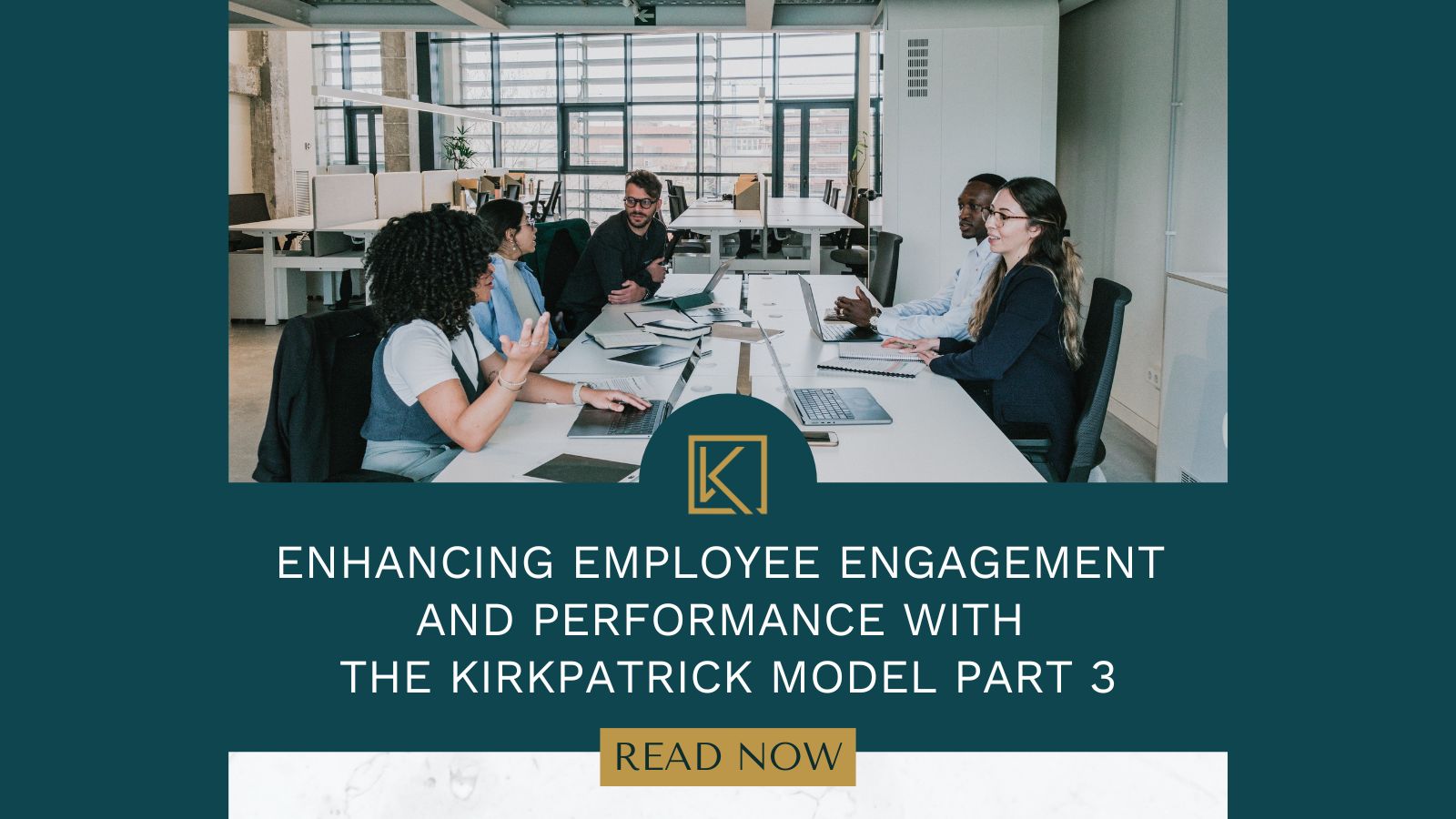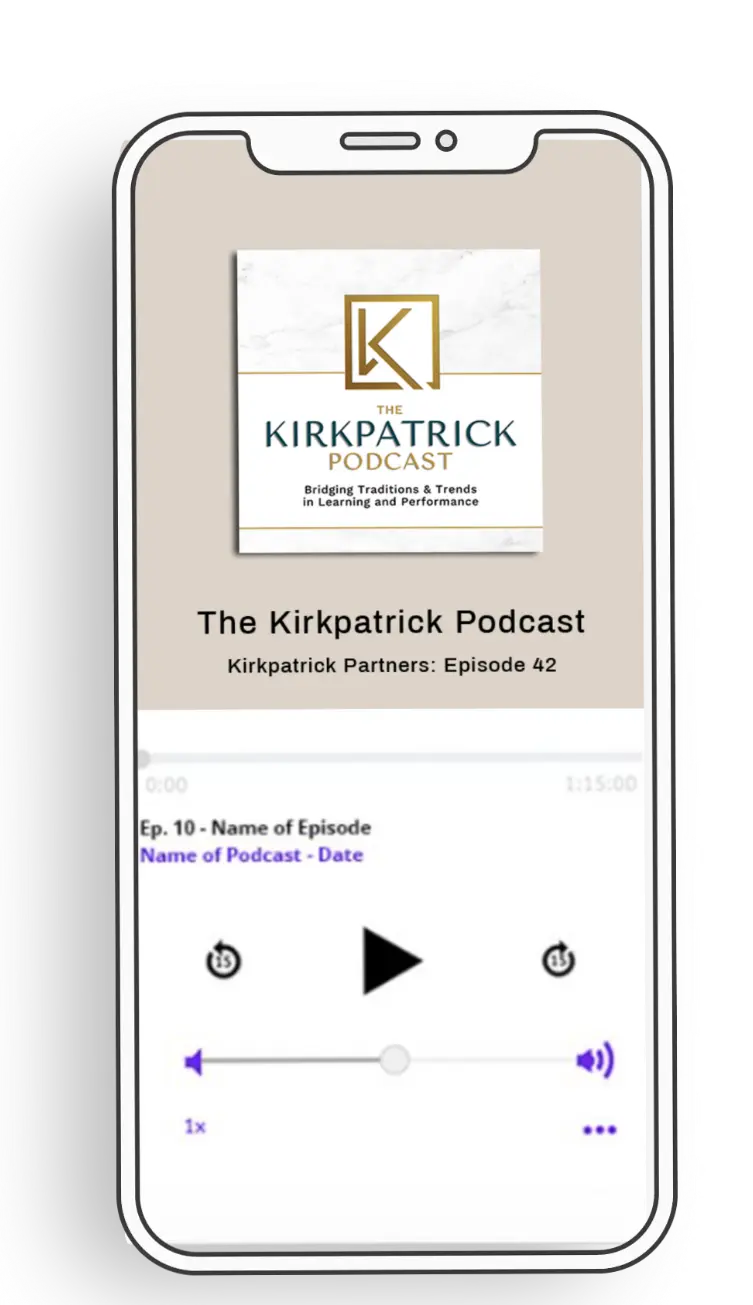Enhancing Employee Engagement and Performance with the Kirkpatrick Model Part 3

The Kirkpatrick Model is widely recognized for evaluating training programs, but its flexibility allows for innovative applications beyond traditional uses, such as assessing employee engagement. Here’s how to use this model effectively to enhance employee engagement and confidence.
Cultivating Confidence
Confidence in the workplace plays a pivotal role in cultivating a positive environment and enhancing employee morale. When employees feel confident about their roles, their abilities, and their place within the organization, they are more likely to contribute positively and remain committed.
Actionable Tips to Cultivate Confidence:
- Onboarding Pulse Checks: Regularly assess new hires’ understanding of company culture and norms through quick surveys or feedback sessions.
- Mentorship Programs: Pair new hires with mentors who can guide them and reinforce their sense of belonging and competence.
- Early Feedback: Provide timely and constructive feedback to help new employees feel confident and valued.
By actively fostering confidence, organizations not only improve individual employee satisfaction and performance but also create a more dynamic and supportive workplace culture. This, in turn, contributes to overall organizational success and employee retention.
Emphasizing Experience Over Measurement
While measuring engagement through surveys is a common practice, focusing on the overall employee experience is essential for achieving genuine and lasting engagement. Surveys can provide valuable data, but they often capture only a snapshot of employees’ attitudes and may not fully reflect the depth of their engagement. To create a truly engaged workforce, it’s important to go beyond survey metrics and consider the broader context of employees’ experiences.
Actionable Tips to Recognize Experience:
- Interactive Engagement: Use interactive methods that foster personal connections, such as team-building activities and one-on-one meetings.
- Human-Centric Approaches: Treat employees as individuals rather than numbers. Techniques like informal check-ins can help in understanding their true sentiments.
- Creating Safe Spaces: Implement regular “open chair” sessions where employees can freely share their thoughts and concerns.
When organizations focus on the overall employee experience, they can create a more comprehensive and meaningful approach to engagement. This not only addresses the immediate needs of employees but also builds a supportive and dynamic work environment that fosters long-term engagement and satisfaction.
Exploring New Measurement Techniques
Relying solely on engagement surveys provides a limited view of employee sentiments and engagement levels. While surveys are useful for gathering quantitative data on employee attitudes and satisfaction, they often fail to capture the full scope of employees’ experiences and feelings. To obtain a more comprehensive understanding of employee sentiments, it is crucial to adopt a multifaceted approach.
Actionable Tips for Going Beyond Surveys:
- Passive Listening: Monitor community platforms, intranet traffic, and social media channels for insights on employee engagement and sentiment.
- Continuous Learning: Find industry peers or mentors to learn about new engagement measurement techniques and start with small pilot projects.
- Transparency: Communicate openly about your intentions to improve engagement practices, which can foster a culture of trust and openness.
By broadening your approach to include these diverse methods, you gain a more comprehensive understanding of employee sentiments. This holistic view allows for more effective interventions and strategies to enhance engagement, ultimately leading to a more satisfied and motivated workforce.
Closing the Feedback Loop
Gathering feedback is just the first step; following up is essential for maintaining trust and encouraging ongoing participation from employees. While collecting feedback provides valuable insights into employee experiences and needs, the true impact of this feedback is realized only when it is actively addressed and acted upon.
Actionable Tips for Effective Follow Up:
- Acknowledge Feedback: Even if you can’t address every concern, provide feedback to employees that their input is being considered and acted upon.
- Action Plans: Share updates on changes being implemented in response to employee feedback to demonstrate that their voices are making a difference.
- Regular Updates: Keep employees informed about the progress and outcomes of their feedback to reinforce trust and engagement.
To effectively close the feedback loop, organizations must maintain trust, enhance engagement, and foster a culture of continuous improvement. Ensuring that feedback is not only gathered but acted upon and communicated back to employees is essential for building a collaborative and responsive work environment.
The Kirkpatrick Model in Action
By applying the Kirkpatrick Model in these innovative ways, you can enhance employee engagement and confidence more effectively. Explore new methods, prioritize genuine experiences, and ensure robust feedback mechanisms to create a more engaged and motivated workforce.
Interested in learning more? Check out the latest episode of the Kirkpatrick Podcast as Vanessa Alzate and Jim Kirkpatrick dive into the first two levels of the Kirkpatrick Model, Reaction and Learning, and discuss their role in enhancing employee engagement. You’ll hear about practical strategies for gauging initial reactions and measuring learning outcomes to set the stage for deeper engagement and lasting behavior change. If you’re ready to unpack the nuances of Levels 1 and 2, and take away even more actionable insights to apply to your learning and development programs, start listening now!
LEARN WITH US
If you are on the search for a community that gets you and can provide you with that support you’ve been looking for, we would love to have you as a part of our Kirkpatrick Community! Learn more and join here.
Check out the most recent episode of the Kirkpatrick Podcast
Don’t forget, the true magic happens when we modernize our training methods and see concrete results. Cultivating an environment of trust, active participation, and continuous enhancement increases the likelihood of our training programs’ success.
Interested in mastering the Kirkpatrick Model? Dive into the Kirkpatrick Evaluation Toolkit, your comprehensive resource for streamlined and impactful evaluation. Learn more here!





